C-Lens Fiber Optic Collimators/Couplers, Single Mode Fiber

- C-Lens Couples and Collimates Light
- AR-Coated Lens Surface
- 1550 nm Alignment Wavelength
- Long 100 mm Working Distance
CFLS155A
C-Lens is Housed Inside a
Ø3.4 mm Stainless Steel Housing
Working Distance
Free-Space Beam
C-Lens Collimator
C-Lens Collimator
Collimator Pair
Laser-to-Fiber Coupling
Free-Space Beam
C-Lens Collimator

Please Wait
| Key Specifications | |
|---|---|
| Collimator Pair Performance | |
| Working Distance | 100 mm ± 10 mm |
| Individual Performance | |
| Beam Diameter (at Working Distance) |
≤0.5 mm FWHM |
| Beam Divergence | ≤0.30° |
| General | |
| Clear Aperture | Ø1.8 mm |
| Optical Power | 300 mW (Max) |
| C-Lens Material | Borosilicate |
| AR Coating | Rmax <0.25% at 1550 nm |
| Tensile Load | 5 N (Max) |
| Fiber Jacket | Ø900 µm Tubing (White) |
| Operating Temperature | 0 to 60 °C |
| Storage Temperature | -40 to 85 °C |
Features
- Couple and Collimate Light In or Out of a Fiber
- Lens Surface is AR Coated for 1550 nm
- Ø1.8 mm Clear Aperture
- 300 mW Maximum Power
- Pigtailed to SM Fiber with an Optional FC/PC or FC/APC Connector
- Long Collimator-to-Collimator Working Distance of 100 mm
Thorlabs offers pigtailed fiber collimators that use C-lenses. These C-lens collimators feature a Ø1.8 mm clear aperture and are coupled to SMF-28 Ultra single mode fiber. They are designed to be used in pairs, with a free-space beam between the lenses, and can also be used individually. We offer models centered at 1550 nm with a choice of an unterminated scissor-cut fiber end, a 2.0 mm narrow key FC/PC connector, or a 2.0 mm narrow key FC/APC connector.
C-Lenses and GRIN lenses are both cylindrical lenses used for fiber collimation; however, while a GRIN lens has a flat face, a C-lens features a curved face like a traditional convex lens (in this case with a 1.8 mm radius of curvature). Refracting light in this way allows for longer working distance collimators with lower insertion loss than our GRIN collimators for applications requiring more involved free-space beam manipulation. For Thorlabs' complete selection of fiber collimators, please see the Collimator Guide tab.
Free-Space Coupling
When using C-lens collimators to couple a free-space beam into a fiber, precise alignment is needed for good coupling efficiency. We recommend using a kinematic tip and tilt mount and lens tube adapter, paired with an XYZ adjustable platform (such as our
POLARIS-K05T6 Mirror Mounts, SM05PT Adapters, sold below, and MT3 XYZ Translation Stages), or our 6-axis kinematic mount paired with a lens tube adapter (Item #s K6XS and SM1PT, sold below).
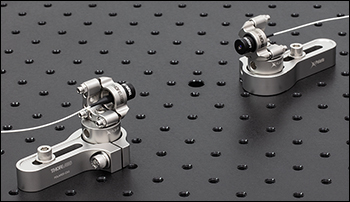
Click to Enlarge
C-Lens Collimator Pair with Free-Space Beam, Mounted with
POLARIS-K05T6 Mirror Mounts and SM05PT Adapters (Sold Below)
Collimator Pair with Free-Space Beam
Our C-lens pigtailed collimators are designed to be used in pairs, with a free-space beam between the lenses (see photo to the left). This free-space beam can be manipulated with many types of optics prior to entering the second lens. The collimators should be placed with a spacing of 100 ± 10 mm (working distance) between the front lens surfaces for maximum coupling efficiency. When used within the specified working distance and mounted on tip-tilt mounts as described in Free-Space Coupling, above, typical insertion losses of less than 0.2 dB are possible.
Click on the Pair Performance icon in the table below to view experimentally measured coupling efficiency data for the collimator pair as a function of the spacing between the collimators. Although the optimal working distance will slightly deviate for any two individual collimators due to small manufacturing variations, these slight deviations do not significantly affect pair or individual performance. This is evidenced by the data given below, which was taken with randomly selected collimators. To achieve the best possible coupling, we recommend mounting both collimators in kinematic adjustable mounts, such as the POLARIS-K05T6 Mirror Mount with SM05PT Adapter, sold below, for final alignment. All specifications, including beam diameter, beam distance, and pair insertion loss, are guaranteed at a working distance of 100 mm for a collimator pair.
Thorlabs' FiberBench, which can accommodate pre-aligned FiberPort collimators and allows modular optical components to be placed in the beam path, is offered for modular fiber/free-space setups.
Insights into Best Lab Practices
Scroll down to read about some practices we follow when setting up lab equipment.
- Align Fiber Collimators to Create Free Space Between Fibers
- Fiber Collimators: Tip for Mounting with Adapters
Click here for more insights into lab practices and equipment.
Align Fiber Collimators to Create Free Space Between Fibers
Two collimators, inserted into a fiber optic setup, provide free-space access to the beam. The first collimator accepts the highly diverging light from the first fiber and outputs a free-space beam, which propagates with an approximately constant diameter to the second collimator. The second collimator accepts the free-space beam and couples that light into the second fiber. Some collimation packages, including the pair used in this demonstration, are designed for use with optical fibers and mate directly to fiber connectors.
Ideally, 100% of the light emitted by the first fiber would be coupled into the second fiber, but some light will always be lost due to reflections, scattering, absorption, and misalignment. Misalignment, typically the largest source of loss, can be minimized using the alignment and stabilization techniques described in this video.
In this demonstration, the first fiber is single mode. The optical power incident on the second collimator, as well as the power output by the second fiber, are measured. When the second fiber is multimode with a 50 µm diameter core, alignment resulted in 91% of the power incident on the second collimator being measured at the fiber output. This value was 86% when the second fiber is single mode. Some differences in collimator designs, and their effects on the characteristics of the collimated beams, are also discussed.
If you would like more information about tips, tricks, and other methods we often use in the lab, we recommend our other Video Insights. In addition, our webinars provide practical and theoretical introductions to our different products.
| Products Featured During Demonstration | ||||
|---|---|---|---|---|
| Fiber-Coupled Laser | Kinematic Mounts | Fiber Adapter Cap (for Power Sensor) |
Single Mode Patch Cable (FC/PC) | Fiber Cable Storage Reels |
| Triplet Fiber Optic Collimators | Power Sensor | Power Meter | Hybrid Single Mode Patch Cable | 2" Posts |
| Adapter (Mount-to-Collimator) |
SM1 Thread Adapter (for Power Sensor) |
Fiber Connector Cleaner | Step-Index Multimode Patch Cable | Ø1/2" Post Holders |
Date of Last Edit: April 21, 2021
Fiber Collimators: Tip for Mounting with Adapters
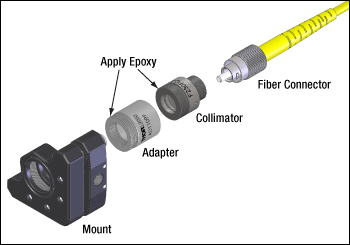
Click to Enlarge
Figure 1: The components shown above are joined using threaded interfaces. Since unscrewing the fiber connector could unintentionally loosen connections between the other components, Thorlabs suggests applying epoxy to the other two interfaces to immobilize them.
Fiber collimators are often used to introduce light into an optical setup from a fiber coupled source. Thorlabs offers a variety of fiber collimator packages, some only provide a smooth barrel (like the triplet collimators) and others have a metric thread at the end of the barrel (like the asphere collimators).
For both packages, Thorlabs typically suggests the use of an adapter with a nylon tipped set screw that holds the barrel against a two line contact.
Adapters for the external thread are available (AD1109F) that allow the user to thread the fiber collimator into a mount.
However, the use of these adapters results in a stack up of threaded interfaces (threaded fiber connector, threaded collimator, and threaded adapter). As a result, it is possible that unscrewing the fiber connector could inadvertently loosen another thread interface and create an unknown source of instability in the setup.
For this reason, Thorlabs suggests epoxying the threaded fiber collimators into the threaded mounts if that mounting mechanism is preferred.
Figure 1 indicates the assembly order and places to apply the epoxy.
Date of Last Edit: Dec. 4, 2019
| Posted Comments: | |
| No Comments Posted |
Fiber Collimator Selection Guide
Click on the collimator type or photo to view more information about each type of collimator.
| Type | Description | |
|---|---|---|
| Fixed FC, APC, or SMA Fiber Collimators | 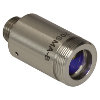 |
These fiber collimation packages are pre-aligned to collimate light from an FC/PC-, FC/APC-, or SMA-terminated fiber. Each collimation package is factory aligned to provide diffraction-limited performance for wavelengths ranging from 405 nm to 4.55 µm. Although it is possible to use the collimator at detuned wavelengths, they will only perform optimally at the design wavelength due to chromatic aberration, which causes the effective focal length of the aspheric lens to have a wavelength dependence. |
| Air-Spaced Doublet, Large Beam Collimators | 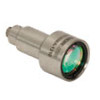 |
For large beam diameters (Ø5.3 - Ø8.5 mm), Thorlabs offers FC/APC, FC/PC, and SMA air-spaced doublet collimators. These collimation packages are pre-aligned at the factory to collimate a laser beam propagating from the tip of an FC or SMA-terminated fiber and provide diffraction-limited performance at the design wavelength. |
| Triplet Collimators | 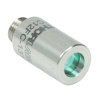 |
Thorlabs' High Quality Triplet Fiber Collimation packages use air-spaced triplet lenses that offer superior beam quality performance when compared to aspheric lens collimators. The benefits of the low-aberration triplet design include an M2 term closer to 1 (Gaussian), less divergence, and less wavefront error. |
| Achromatic Collimators for Multimode Fiber | 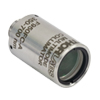 |
Thorlabs' High-NA Achromatic Collimators pair a meniscus lens with an achromatic doublet for high performance across the visible spectrum with low spherical aberration. Designed for use with high-NA multimode fiber, these collimators are ideal for Optogenetics and Fiber Photometry applications. |
| Reflective Collimators | 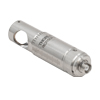 |
Thorlabs' metallic-coated Reflective Collimators are based on a 90° off-axis parabolic mirror. Mirrors, unlike lenses, have a focal length that remains constant over a broad wavelength range. Due to this intrinsic property, a parabolic mirror collimator does not need to be adjusted to accommodate various wavelengths of light, making them ideal for use with polychromatic light. Our reflective collimators are ideal for collimating single mode fiber but are not recommended for coupling into single mode fiber. We also offer a compact version of the protected-silver-coated reflective collimators that is directly compatible with our 16 mm cage system. |
| FiberPorts | 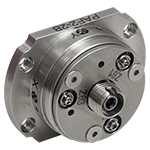 |
These compact, ultra-stable FiberPort micropositioners provide an easy-to-use, stable platform for coupling light into and out of FC/PC, FC/APC, or SMA terminated optical fibers. It can be used with single mode, multimode, or PM fibers and can be mounted onto a post, stage, platform, or laser. The built-in aspheric or achromatic lens is available with five different AR coatings and has five degrees of alignment adjustment (3 translational and 2 pitch). The compact size and long-term alignment stability make the FiberPort an ideal solution for fiber coupling, collimation, or incorporation into OEM systems. |
| Adjustable Fiber Collimators |  |
These collimators are designed to connect onto the end of an FC/PC, FC/APC, or SMA connector and contain an AR-coated aspheric lens. The distance between the aspheric lens and the tip of the fiber can be adjusted to compensate for focal length changes or to recollimate the beam at the wavelength and distance of interest. |
| Achromatic Fiber Collimators with Adjustable Focus |  |
Thorlabs' Achromatic Fiber Collimators with Adjustable Focus are designed with an effective focal length (EFL) of 20 mm, 40 mm, or 80 mm, have optical elements broadband AR coated for one of three wavelength ranges, and are available with FC/PC, FC/APC, or SMA905 connectors. A four-element, air-spaced lens design produces superior beam quality (M2 close to 1) and less wavefront error when compared to aspheric lens collimators. These collimators can be used for free-space coupling into a fiber, collimation of output from a fiber, or in pairs for collimator-to-collimator coupling over long distances, which allows the beam to be manipulated prior to entering the second collimator. |
| Zoom Fiber Collimators | 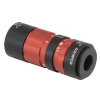 |
These collimators provide a variable focal length between 6 and 18 mm, while maintaining the collimation of the beam. As a result, the size of the beam can be changed without altering the collimation. This universal device saves time previously spent searching for the best suited fixed fiber collimator and has a very broad range of applications. They are offered with FC/PC, FC/APC, or SMA905 connectors with three different antireflection wavelength ranges to choose from. |
| Single Mode Pigtailed Collimators | 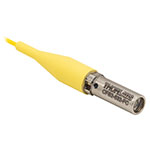 |
Our single mode pigtailed collimators come with one meter of fiber, consist of an AR-coated aspheric lens pre-aligned with respect to a fiber, and are collimated at one of eight wavelengths: 532 nm, 633 nm, 780 nm, 850 nm, 1030 nm, 1064 nm, 1310 nm, or 1550 nm. Although it is possible to use the collimator at any wavelength within the coating range, the coupling loss will increase as the wavelength is detuned from the design wavelength. |
| Polarization Maintaining Pigtailed Collimators | 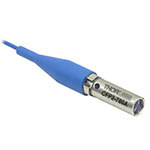 |
Our polarization maintaining pigtailed collimators come with one meter of fiber, consist of an AR-coated aspheric lens pre-aligned with respect to a fiber, and are collimated at one of six wavelengths: 532 nm, 830 nm, 1030 nm, 1064 nm, 1310 nm, or 1550 nm. Custom wavelengths and connectors are available as well. A line is engraved along the outside of the housing that is parallel to the slow axis. As such, it can be used as a reference when polarized light is launched accordingly. Although it is possible to use the collimator at any wavelength within the coating range, the coupling loss will increase as the wavelength is detuned from the design wavelength. |
| GRIN Fiber Collimators | 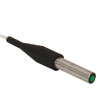 |
Thorlabs offers gradient index (GRIN) fiber collimators that are aligned at a variety of wavelengths from 630 to 1550 nm and have either FC terminated, APC terminated, or unterminated fibers. Our GRIN collimators feature a Ø1.8 mm clear aperture, are AR-coated to ensure low back reflection into the fiber, and are coupled to standard single mode or graded-index multimode fibers. |
| GRIN Lenses | 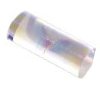 |
These graded-index (GRIN) lenses are AR coated for applications at 630, 830, 1060, 1300, or 1560 nm that require light to propagate through one fiber, then through a free-space optical system, and finally back into another fiber. They are also useful for coupling light from laser diodes into fibers, coupling the output of a fiber into a detector, or collimating laser light. Our GRIN lenses are designed to be used with our Pigtailed Glass Ferrules and GRIN/Ferrule sleeves. |

| Item # | Fiber Termination | Wavelength Range |
Center Wavelength |
Length (Fiber Type) | Pair Insertion Lossa,b |
Pair Performance |
Insertion Lossa,c |
Return Loss (Min)a,c |
|---|---|---|---|---|---|---|---|---|
| CFLS155 | Scissor Cut | 1520 - 1580 nm | 1550 nm | 1 m (SMF-28 Ultra) |
<0.2 dB | (Raw Data) |
<0.30 dB | 60 dB |
| CFLS155F | FC/PC | |||||||
| CFLS155A | FC/APC |

| Item # | External Threading | Compatible Component Size | Length | |
|---|---|---|---|---|
| Diameter | Length | |||
| SM05PT | SM05 (0.535"-40) | 3.5 mm | ≥0.26" (6.6 mm) | 0.50" (12.7 mm) |
| SM1PT | SM1 (1.035"-40) | |||
- External SM05 (0.535"-40) or SM1 (1.035"-40) Threads
- Ø0.14" (Ø3.5 mm) Center Hole
- Nylon-Tipped Setscrew Secures C-Lens Collimator
These adapters are designed to mount Thorlabs' C-Lens Fiber Collimators in SM05- or SM1-compatible mounts, lens tubes, and cage components. The adapters' design ensures that the C-lens is aligned with the optical axis when mounted into a lens tube. A 1/16" (1.5 mm) hex, nylon-tipped setscrew is used to press the C-lens fiber collimator against the two lines of contact created by the double-bored mounting hole. Additionally, each adapter has holes on opposing sides of the central bore for use with a spanner wrench. The SM05PT is compatible with the SPW908 spanner wrench while the SM1PT is compatible with the SPW801 and SPW909 spanner wrenches.

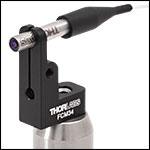
Click to Enlarge
FCM34 Ferrule Clamp with a C-Lens Collimator
- Compact Flexure Clamp for Ø3.4 mm C-Lens Collimator Housing
- 8-32 (M4) Tapped Mounting Hole
- Compatible with Ø1/2" Optical Posts
This Post-Mountable Ferrule Clamp allows C-Lens Collimators to be mounted securely and compactly within an experimental setup. The collimator is clamped into the flexure mount using a 5/64" (2 mm) hex key. An 8-32 (M4) tapped hole on the bottom of the mount provides compatibility with our Ø1/2" optical posts.
 Products Home
Products Home











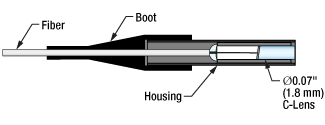

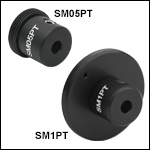
 Zoom
Zoom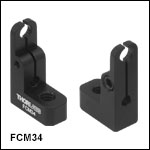
 SM Pigtailed C-Lens Collimators
SM Pigtailed C-Lens Collimators